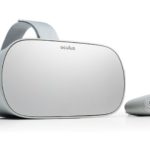Convenience comes to virtual reality with Oculus Go
New VR headsets like Oculus Go and HTV Pro are becoming more accesible and dropping barries to entry for a wider range of audience.

Right in front of your eyes, Disney's immense castle. With Walt Disney himself and his most famous character, Mickey Mouse, receiving visitors with a smile and a gesture of welcome, sculpted in bronze. That's the north. To the east, the most recognized score in the history of cinema, the theme created by John Williams for the 1977 classic, 'Star Wars'. The sky fills with giant Star Destroyers, the ships used by the Galactic Empire. And in the west ... In the west there are superheroes, the ones from the Marvel movies with giant New York skyscrapers, emblematic of its most famous saga: 'The Avengers'.
What is truly important is that this fantasy world has exactly the same size and appearance as it would have if it existed in the real world. Because it is an example of what can be seen with virtual reality viewer. It is seen through the lens of an Oculus Go.
Now you don't have to be at home to travel to other worlds. For this Oculus Go trial, one of the selected trips through the Melody VR application was to a KISS concert. 18,000 fans roaring under the glow of spotlights and lasers. In reality, this test happened in a quiet park in Madrid, on a picnic blanket spread out on the grass.

An example of what can be seen with virtual reality sets like Oculus Go.
It is perhaps the best demonstration of the power of virtual reality: the chance to travel from a real place in the world to someplace completely different. Virtual reality goggles are truly time and space machines. And even something more: they are the vehicle to use to travel to any invented universe.
Oculus Go makes this journey much more accessible. Currently, the biggest problem with virtual reality is precisely accessibility. The top of the line headsets, Oculus and HTC, require a computer and enough free space at home to set up an area where we can move around without bumping into things. The situation is similar with the most sold home VR system, the PlayStation VR, which needs the ingenious machine to also be plugged into a Playstation 4 console. But Oculus Go frees us from cables. This is the first significant differentiator from other similar headsets: the freedom of movement.
Another critical topic is price. A top of the range virtual reality experience costs thousands of dollars: approximately $1,000 for the HTC Vive Pro, plus the additional cost of the computer required to fluidly reproduce the audiovisual experience. The Oculus Go removes this barrier. At just $199 for the 32-gig onboard storage version and $249 for 64 gigs.

This main significant differentiator from other similar headsets is the freedom of movement.
There is absolutely nothing more to buy. It also comes with a controller, designed for those who aren't used to playing video games. The controller is one of the successes of the design. It is held with only one hand and is intended for first person world exploration. It has a circular shape, a trigger to perform actions, and two buttons for menu navigation. Also, it weighs hardly anything and feels natural in the hand, improving on one of the problems that non-gamers tend to have with virtual reality: having to use a complex controller when we can't see our hands.
Virtual reality is a new medium which is striving to convince the more conventional consumer to give it a try. Oculus Go is a step in the right direction for Facebook because it drops barriers to entry and adapts its design to a wider range of audience. Having a bulky headset that insulates us from the exterior world is still somewhat uncomfortable.
And, it has to be acknowledged that its image quality does not reach the levels of more expensive goggles. But it does allow us to comfortably enjoy virtual reality for the first time without losing the most spectacular aspects of the experience. Ultimately it is proof that virtual reality can be much more comfortable. Though there is still some way to go.